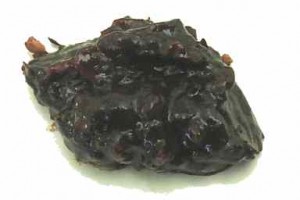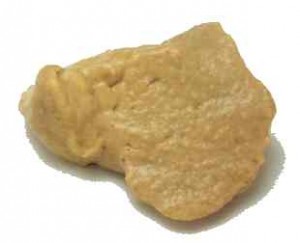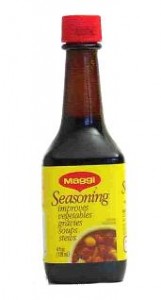Asian Condiments
http://asiarecipe.com/asiancondi.html
 |
Asian barbecue sauce Notes: This is made with oil, soy sauce, and other seasonings. Don’t confuse it with the much sweeter American barbecue sauce. |
|
|
Asian chili paste |
|
|
Bainiku See umeboshi puree. |
|
|
Bean Paste This name is used for both bean sauce and miso. |
 |
Bean Sauce = Bean Paste = Brown Bean Sauce = Brown Bean Paste = Soybean Condiment = Yellow Bean Sauce = Yellow Bean Paste = Yuan Shai Shih = Mo Yuen Shih Notes: This salty brown sauce is made from fermented soybeans, and is available in cans or jars. If you buy it in a can, transfer it into a jar. It can then be stored indefinitely in the refrigerator. Chinese bean sauce isn’t as salty as Thai bean sauce. Substitutes: black bean sauce OR chili bean sauce OR awase miso OR brown miso |
|
|
Belacan See shrimp paste. |
 |
Black Bean Sauce To make your own: See the Asian Black Bean Sauce posting on RecipeSource.com. Notes: This is made from fermented black beans. A variation is hot black bean sauce, which has chile paste added, and black bean sauce with garlic.. Substitutes: (brown) bean sauce OR hot black bean sauce |
|
|
Brown Bean Paste |
|
|
Brown Bean Sauce |
 |
Chee Hou Sauce = Che Hau Sauce = Chu Hou Paste Shopping hints: This braising sauce is made from soybeans, garlic, and ginger. Look for it in the condiments section of Asian markets. Substitutes: hoisin sauce (Very similar, but less spicy.) |
 |
Chili Bean Paste = Chili Bean Paste = Chili Bean Sauce = Chilli Bean Sauce = Bean Paste With Chili = Hot Bean Paste Notes: This reddish-brown sauce is made from fermented soybeans and hot chilies. It’s very hot. Regional versions include Sichuan hot bean paste = Szechuan hot bean paste, and Korea’s kochu chang = kochujang. Substitutes: bean sauce + chile paste OR bean sauce + chopped chile peppers |
|
|
Chili Paste = Asian Chile Paste = Chili Paste = Chilli Paste Notes: This is a blend of hot chile peppers, garlic, oil, and salt that’s commonly used in Asian cuisine. Includes: Chinese chile (or chili) paste = Szechuan chile (or chili) paste = Sichuan chile (or chili) paste = chile paste with garlic, Korean chile paste, and Vietnamese chile paste = tuong ot toi Vietnam = prik kaeng, which is hotter than the Chinese chile paste. See also separate entries for these other chile pastes: nam prik pao, chile bean paste, sambal oelek, and sambal bajak. Substitutes: hot sauce OR harissa OR crushed red pepper flakes (to taste; start with 1/4 as much) OR dried red chili peppers |
|
|
Chili Bean Paste |
|
|
Chili Paste |
|
|
Chinese Chile (Or Chili) Paste |
|
|
Chinese Duck Sauce See Plum Sauce. |
 |
Chinese Mustard = Chinese Hot Mustard To make your own: Gradually add 1/4 cup boiling water to 1/4 cup dry English mustard, stirring constantly, then add 1 teaspoon oil. |
|
|
Chinese plum sauce See plum sauce. |
 |
Coconut Egg Jam = Coconut Jam = kaya Notes: Southeast Asians spread this exquisite jam on toast, but it would also be great on ice cream. Look for small cans of it in Asian markets. To make your own: Visit the Coconut Egg Jam recipe page, or the Kaya, Traditional Coconut Jam page. |
 |
Dwen Jang = Customary Soy Bean Paste Notes: This is a salty Korean bean paste. Substitutes: red miso |
|
|
Duck Sauce See Plum Sauce. |
  |
Fish Sauce = Fish Gravy Notes: Varieties include Thai fish sauce = nam pla, Vietnamese fish sauce = nuoc mam, patis, a Filipino fish sauce that isn’t as highly regarded as the Vietnamese or Thai versions, and shottsuru, a Japanese fish sauce. Substitutes: light soy sauce OR To make your own mock fish sauce, simmer for 10 minutes: 1 can drained anchovies + 2 cloves bruised and peeled garlic + ½ teaspoon brown sugar + ¼ teaspoon salt + 1 ¼ cups water, then strain. (Adapted from a recipe in the All Around the World Cookbook by Sheila Lukins. See my sources.) OR simmer for 10 minutes: 1 part soy sauce + 4 parts anchovies (Adapted from a recipe in Substituting Ingredients by Becky Sue Epstein and Hilary Dole Klein. See my sources.) OR soak anchovies from one small can (about 14 fillets) in 1 C water, strain, then add 2 tablespoons soy sauce. Notes: See also the RecipeSource.com posting Fish Sauce (Nuoc Mam) which discusses the best Vietnamese fish sauce brands. |
 |
Green Curry Paste = Nam Prik Kaeng Khiao Wan To make your own: Curry Paste (Thailand). |
|
|
Ground Fish Sauce Substitutes: Thai fish sauce OR Vietnamese fish sauce |
 |
Hoisin Sauce Notes: This is a sweet and garlicky bean sauce that’s often used as a dipping sauce. Available in Asian markets and in many large supermarkets. To make your own: Visit the Hoisin Sauce Substitutes: Simmer for 12 minutes: ¾ C pitted prunes + 2 C water + 1 tablespoon crushed garlic, then add 1 ½ tablespoons soy sauce + 1 ½ tablespoons dry sherry and puree. (Adapted from recipe in Good & Plenty: America’s New Home Cooking by Victoria Wise and Susanna Hoffman. See my sources.) OR ¼ C soy sauce + ¼ C plum sauce + 1 teaspoon flour + dash five-spice powder + dash garlic powder + sugar or honey to taste (From a usenet posting by Lynn M. Wiegard. See my sources.) OR chee hou sauce (spicier) OR apple butter (Thanks to reader Richard Nolles for this suggestion.) OR sweet bean sauce (spicier) |
|
|
Hot Bean Paste |
|
|
Hot Chili Sauce To make your own: Visit the Hot Chili Sauce |
| Hot Garlic Sauce Substitutes: any Asian hot chile paste | |
| Indonesian Sweet Soy Sauce See kecap manis. | |
|
|
Japanese Horseradish See wasabi. |
|
|
Japanese Soy Sauce = shoyu Substitutes: light Chinese soy sauce |
|
|
Kacang Saus Substitutes: kecap manis |
|
|
Kapi See shrimp paste. |
 |
Kecap Manis = Ketjap Manis = Kejap Manis = Indonesian Sweet Soy Sauce Pronunciation: kuh-CHOP MAH-nees Notes: This thick, dark sauce is the Indonesian ancester of ketchup. Look for it in Indonesian markets. To make your own: See the recipes for Ketjap Manis or Kecap Manis posted on SOAR. Substitutes: Combine equal parts soy sauce and either brown sugar or molasses, and simmer until sugar is dissolved. OR Maggi’s seasoning sauce (not as sweet) |
|
|
Kochu Chang |
|
|
Kochujang |
 |
Korean Barbecue Sauce = Bulgogi Sauce = Bulkogi Sauce |
|
|
Korean chile paste |
 |
Maggi’s Seasoning Sauce Substitutes: equal parts dark soy sauce and Worcestershire sauce (From a usenet posting by Colonel I.F.K. Philpott. See my sources.) OR Thai sweet soy sauce OR mushroom soy sauce |
|
|
Mam Tom See Shrimp Paste. |
|
|
Mushroom Soy Sauce Substitutes: Dark Soy Sauce |
|
|
Nam Pla See Fish Sauce. |
|
|
Nam Prik = Nam Phrik Notes: This is a general Thai term for dipping sauces. Examples are nam prik pao, green curry paste = nam prik kaeng khiao wan, red curry paste = nam prik kaeng daeng, and yellow curry paste = nam prik kaeng kari |
|
|
Nam Prik Kaeng Daeng |
|
|
Nam Prik Kaeng Kari |
|
|
Nam Prik Kaeng Khiao Wan |
|
|
Nam Prik Pao = Thai Chile Paste = Thai Chili Paste Notes: This paste is made from chilies, onions, sugar, shrimp paste, fish sauce, and sometimes tamarind. It’s sold in jars, and comes in different strengths, ranging from hot to mild. To make your own: See the recipe for nam prik pao |
|
|
Nuoc Cham = Vietnamese Hot Sauce To make your own: Nuoc Cham |
|
|
Nuoc Mam See Fish Sauce. |
 |
Oyster Sauce Notes: This Cantonese dipping sauce is both sweet and salty. Look for bottles of it in Asian markets and large supermarkets. Substitutes: Bring to a boil, then simmer in a covered pot for 30 minutes: 2 C fresh oysters + 3 C water + 1 C bottled clam juice + 1 teaspoon salt + 1 clove of garlic + white portion of 1 green onion + 1 slice of fresh ginger root, then add a mixture of 1/4 C soy sauce + 1 teaspoon sugar + 2 teaspoons cornstarch + 3 tablespoons water, and simmer for 10 more minutes, stirring occasionally, then strain out the solids in the sauce and discard. (adapted from a recipe in Jennifer Brennan’s excellent book, The Cuisines of Asia. See my sources.) OR soy sauce |
|
|
Patis See Fish Sauce. |
| Plum Sauce = Chinese Duck Sauce = Chinese Plum Sauce = Duck Sauce chutney (thicker and hotter) To make your own: See the Chinese Duck Sauce | |
|
|
Prik Kaeng |
|
|
Red Bean Curd = Red Bean Curd Cheese = Red Preserved Bean Curd |
 |
Red Sweet Bean Paste = Red Bean Paste = Red Bean Sauce = Sweet Red Bean Paste Notes: This is made from azuki beans, and Asian cooks use it to fill buns and dumplings and to make puddings. Like peanut butter, it comes in both creamy and crunchy versions. The creamy version also comes in powdered form. Don’t confuse this with sweet bean paste, which is made from sweetened fermented soybeans. To make your own: Cook a cup of azuki beans until they’re soft (about 1 1/2 hours), then puree the softened beans in a food processor. Pour the puree into a cotton kitchen towel and squeeze out the water. Put what’s left into a saucepan, add 1 1/2 cups of sugar, 1/2 cup shortening, and a pinch of salt, and heat while stirring until it’s thickened to the consistency of miso. For another recipe, visit the Sweet Red Bean Paste recipe page. |
 |
Red Curry Paste = Nam Prik Kaeng Daeng To make your own:Red Curry Paste |
 |
Sambal Bajak = Sambal Badjak To make your own: See the USENET Cookbook recipe for Sambal Bajak. |
|
|
Sambal Blachan To make your own: See the recipe for Sambal Blachan on Recipecottage.com |
|
|
Sambal Dabo Lilang To make your own: See the USENET Cookbook recipe for Sambal Dabo Lilang. |
 |
Sambal Manis Notes: This Indonesian sauce is used for dipping and stir fries. It’s fairly spicy, but milder than sambal oelek. Substitutes: sambal oelek (hotter) OR soy sauce |
 |
Sambal Oelek = Sambal Ulek To make your own: Mix hot fresh chili peppers (including seeds, if you dare) and a bit of water in a blender until it forms a paste, then add a bit of salt, or see the sambal oelek Substitutes: other chile paste OR harissa OR hot pepper sauce OR red pepper flakes OR chile powder |
|
|
Sambal Ulek |
|
|
Shottsuru See Fish Sauce. |
|
|
Shoyu |
 |
Shrimp Paste = Blachan = Blacan = Balachan = Belacan = Trassi (In Indonesia) = Trasi = Terasi = Kapi = Mam Tom Notes: Look for this in Southeast Asian markets. Substitutes: anchovy paste (not as pungent) OR anchovy fillets mixed with a bit of water |
|
|
|
 |
Soy Sauce Notes: Soy sauce is made from soybeans that have been fermented and salted. It’s used throughout Asian, with different regions producing quite different variations. Japanese soy sauce = shoyu is sweeter and less salty than Chinese soy sauce. Chinese soy sauce comes in light and dark versions. Lite soy sauce has 1/3 less sodium. Substitutes: tamari (thicker) OR Maggi seasoning OR black bean sauce thinned with water OR kecap manis (much sweeter) OR Worcestershire sauce |
|
|
Soybean Condiment |
 |
Sriracha Notes: This is a hot sauce used as a condiment by Thais and Vietnamese. Substitutes: Tabasco sauce or other hot sauce (not as sweet) |
 |
Sweet And Sour Sauce To make your own: Sweet and Sour Sauce |
 |
Sweet Bean Sauce = Sweet Bean Paste Notes: This brown sauce is made from sweetened fermented soybeans. Taiwanese cooks use it as a marinade or a condiment for meats. Substitutes: hoisin sauce (milder) |
|
|
Szechuan Chile (Or Chili) Paste |
 |
Tamari = Wheat-Free Soy Sauce Substitutes: soy sauce (thinner and less rich; made with wheat) |
|
|
Thai Fish Sauce See Fish Sauce. |
|
|
Thai Sweet Soy Sauce Substitutes: Three parts soy sauce plus one part brown sugar OR Maggi’s Seasoning Sauce OR dark soy sauce OR mushroom soy sauce |
|
|
Toi Sauce See Tuong. |
|
|
Tonkatsu Sauce Notes: This Japanese condiment is used to make yakisoba. Bull Dog is a popular brand. |
|
|
Trasi See shrimp paste. |
|
|
Trassi See shrimp paste. |
|
|
Tuong = Toi Sauce = Vietnamese Soy Sauce Notes: This is a salty bean paste used in Vietnamese cuisine. Substitutes: Blend equal parts bean sauce and water |
|
|
Tuong Ot Toi Vietnam |
|
|
Umeboshi Plums Substitutes: 1 teaspoon sea salt per plum substituted |
|
|
Umeboshi Paste See umeboshi puree. |
|
|
Umeboshi Puree = Umeboshi Paste = Bainiku Substitutes: sea salt OR miso OR soy sauce |
|
|
Vietnamese Chile Paste |
|
|
Vietnamese Fish Sauce See Fish Sauce. |
|
|
Vietnamese Hot Sauce |
|
|
Vietnamese Soy Sauce See Tuong. |
|
|
Wasabe See Wasabi. |
 |
Wasabi = Wasabe = Japanese Horseradish Pronunciation: wah-SAH-bee Notes: Look for this in the Asian foods section of your supermarket. It comes either in powdered form or as a paste. To convert the powder into a paste, mix 2 parts wasabi powder with 3 parts water. Substitutes: Blend ground dry mustard with water until it forms a paste |
|
|
X.O. Sauce = X.O. Chili Sauce Notes: Asians pour this sauce over noodles and seafood. It’s made from dried anchovies, shrimp, and chiles. Substitutes: sate sauce |
|
|
Yellow Bean Sauce |
 |
Yellow Curry Paste = Nam Prik Kaeng Kari To make your own: See the recipe for yellow curry paste |

